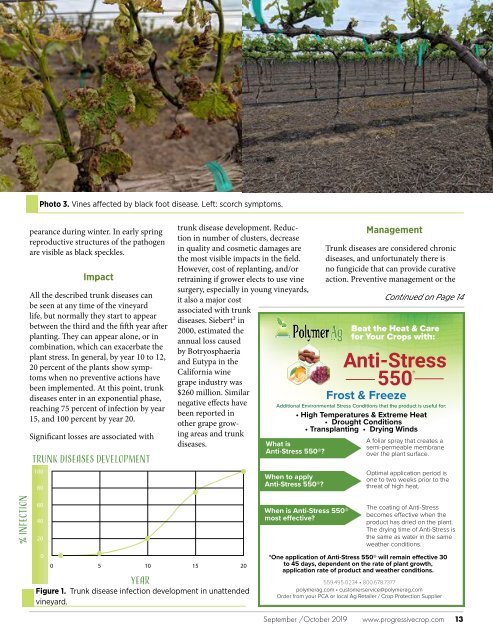PCC Sep Oct 2019
Create successful ePaper yourself
Turn your PDF publications into a flip-book with our unique Google optimized e-Paper software.
Photo 3. Vines affected by black foot disease. Left: scorch symptoms.<br />
pearance during winter. In early spring<br />
reproductive structures of the pathogen<br />
are visible as black speckles.<br />
Impact<br />
All the described trunk diseases can<br />
be seen at any time of the vineyard<br />
life, but normally they start to appear<br />
between the third and the fifth year after<br />
planting. They can appear alone, or in<br />
combination, which can exacerbate the<br />
plant stress. In general, by year 10 to 12,<br />
20 percent of the plants show symptoms<br />
when no preventive actions have<br />
been implemented. At this point, trunk<br />
diseases enter in an exponential phase,<br />
reaching 75 percent of infection by year<br />
15, and 100 percent by year 20.<br />
Significant losses are associated with<br />
Trunk Diseases Development<br />
100<br />
80<br />
trunk disease development. Reduction<br />
in number of clusters, decrease<br />
in quality and cosmetic damages are<br />
the most visible impacts in the field.<br />
However, cost of replanting, and/or<br />
retraining if grower elects to use vine<br />
surgery, especially in young vineyards,<br />
it also a major cost<br />
associated with trunk<br />
diseases. Siebert² in<br />
2000, estimated the<br />
annual loss caused<br />
by Botryosphaeria<br />
and Eutypa in the<br />
California wine<br />
grape industry was<br />
$260 million. Similar<br />
negative effects have<br />
been reported in<br />
other grape growing<br />
areas and trunk<br />
diseases.<br />
Management<br />
Trunk diseases are considered chronic<br />
diseases, and unfortunately there is<br />
no fungicide that can provide curative<br />
action. Preventive management or the<br />
Additional Environmental Stress Conditions that the product is useful for:<br />
What is<br />
Anti-Stress 550®?<br />
When to apply<br />
Anti-Stress 550®?<br />
Frost & Freeze<br />
Continued on Page 14<br />
Beat the Heat & Care<br />
for Your Crops with:<br />
Anti-Stress<br />
550 ®<br />
• High Temperatures & Extreme Heat<br />
• Drought Conditions<br />
• Transplanting • Drying Winds<br />
A foliar spray that creates a<br />
semi-permeable membrane<br />
over the plant surface.<br />
Optimal application period is<br />
one to two weeks prior to the<br />
threat of high heat.<br />
% Infection<br />
60<br />
40<br />
20<br />
0<br />
0<br />
5 10 15 20<br />
Year<br />
Figure 1. Trunk disease infection development in unattended<br />
vineyard.<br />
When is Anti-Stress 550®<br />
most effective?<br />
The coating of Anti-Stress<br />
becomes effective when the<br />
product has dried on the plant.<br />
The drying time of Anti-Stress is<br />
the same as water in the same<br />
weather conditions.<br />
*One application of Anti-Stress 550® will remain effective 30<br />
to 45 days, dependent on the rate of plant growth,<br />
application rate of product and weather conditions.<br />
559.495.0234 • 800.678.7377<br />
polymerag.com • customerservice@polymerag.com<br />
Order from your PCA or local Ag Retailer / Crop Protection Supplier<br />
<strong>Sep</strong>tember /<strong>Oct</strong>ober <strong>2019</strong><br />
www.progressivecrop.com<br />
13


















